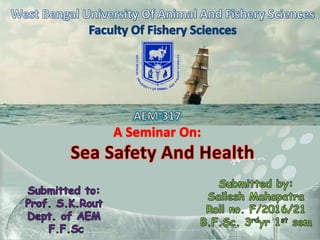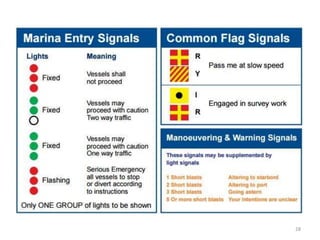Sea Safety and Health
- 1. 1
- 2. Coastal Zone Management & Disaster Management Disaster Management 2 Disaster
- 3. 3
- 4. An ILO report (May 1999) on safety and health in the fishing industry shows that compared to other industries, Fatality rate in fishing is much higher. As per ILO estimates, the fatality rate in fishing at global level is about 77% that is 24000 fatalities per year. In India at the national level one of the major source of information on status of sea safety is Group Accident Insurance Scheme for Active Fishermen of Ministry of Agriculture implemented by the FISHCOPFED and Oriental Insurance Company. 4
- 5. A study carried out by the South Indian Federation of Fishermen Societies (SIFFS) in Tamil Nadu for the period of 2000–07 estimated about 1210 accidents during the period excluding the death due to Tsunami. From the SIFFS study, it can be inferred that the major causes of drowning are capsizing, engine failure and surf crossing mostly during returning from fishing. Another recent study (2004-09) carried out by the Bay of Bengal Programme Inter-Governmental Organization (BOBP-IGO) and National Institute of Occupational Safety and Health (NIOSH,USA). The objective of the study was to found causes of the fishing related accident during that period. The study indicated that in 62% of the cases death was due to drowning. 5 Drowning
- 6. Safety at sea can be defined as a set of measures including policies, technologies, training, which if properly implemented can reduce risk associated with marine fisheries. The best possible way to improve safety and reduce vulnerability of the fishermen is inclusive development policies. 6
- 7. Sea safety history The first international convention concerning safety at sea was SOLAS (Safety of Life at Sea), prompted by the Titanic disaster in 1911. The three organizations of the United Nations, ILO, IMO and FAO have jointly prepared a Code of safety for fishermen and fishing vessels. PART A (Adopted in 1968) PART B (Adopted in 1974) Safety and health practices for skippers and crews Safety and health requirements for the construction and equipment of fishing vessels 7
- 8. The factors or risk profile of a fisher engaged in fishing in the sea can be expressed as: Policy induced risk includes registration and licensing of a fishing vessels. IA induced risks include relationship between boat owner and the fishers, experiences and training. Market conditionalities, like need to land catch before sunrise and lower price competition. Behavioral risks include habits like drinking, ignoring training, not carrying First Aid box, etc. Total risk = Policy-induced risks + Internal Arrangement(IA) induced risks + Market induced risks + Behavioral risks + External(natural risks). 8
- 9. ACCIDENT DEFENSES(inadequate) UNSAFE ACTS PRE-CONDITIONS LINE MANAGEMENT DEFICIENCIES FAILURE DECISIONS ACTIVE AND LATENT FAILURES LATENT FAILURES The complexity of accident causation is illustrated by “Reason’s model” put forward by Prof. James Reason of Manchester University, U.K. 9
- 10. The fishers were not aware of any weather warning and venture into the sea(decision). They possibly did not inform their voyage plan to their family who could call for Search and Rescue Operation(SAR) and they crossed into a shipping route possibly due to lack of navigational training(decision and line management). The sea turned rough (pre-condition). The fishers ventured in to the sea without any personal protection equipment (PPE) like life jacket or buoy(unsafe act). They were not having any communication equipment except the flashlight and even the flashlight not secured (a possible defence). The development of the model shows 10
- 11. Types of accidents Possible reasons Capsizing • Poor stability • heavy loads on deck • water trapped on deck Sinking • Bad construction • Bad maintenance 11
- 12. Drifting • Bad engine installation • Bad maintenance of engines • Lack of fuel • Lack of trouble- shooting experience Collision • Lack of navigation light • Tired crews • Ignorance of driver 12
- 13. Fire • Bad engines installation • Bad installation of cooking stove • Short-circuit Work accidents • Slippery decks • Unprotected machinery • Tired crew 13
- 14. Health outcomes • The most prominent health outcomes resulting from recreational use of water are: Types of health hazard Possible reasons Drowning and near- drowning • Alcohol consumption • Waves (coastal, boat, chop) • Pre-existing disease • Sea current (including tides, undertow and rate of flow) • Offshore winds (especially with flotation devices) • Bottom surface gradient and stability/ • Impeded visibility (including coastal configuration, structures and overcrowding) Major impact injuries, especially spinal injuries • Poor underwater visibility • Bottom surface type • Water depth • Diving into a wave or into water of unknown depth • Jumping into water from trees, balconies or other structures 14
- 15. • Source: WHO, 1998 Types of health hazard Possible reasons Slip, trip and fall injuries (including bone fracture and breaks). Diving into shallow water Underwater objects (e.g. walls, piers) Adjacent surface type (e.g. water fronts, jetties) Poor underwater visibility Cuts, lesions and punctures Presence of broken glass, bottles, cans and medical wastes Walking and entering water barefoot Retinal dislocation “Bombing” (jumping onto other water users) Diving into water/Jumping into water from height 15
- 16. Information : The first and foremost necessity is to set up a proper accident- reporting procedure. Currently, the BOBP-IGO is working with NIOSH(National Institute for Occupational Safety and Health, USA) to formulate an effective accident-reporting mechanism. They provide Group Insurance Scheme for fisher. 16
- 17. Policies : In Indian context fishing is a state subject for inland waters and waters up to 12 nautical miles. Beyond 12 nautical miles to the extent of EEZ fishing comes under central government. Marine Fishing Regulation Act(MFRAs) and Merchant Shipping Act (MSA) provides for registration and licensing of fishing vessel by Dept. of Fisheries of the state (1958). 17
- 18. Considering design of the vessels to designate their area of operation: Fishing vessels meet different sea conditions. The International Standards Organization (ISO) uses the term significant wave height(SWH) which is the average of the 1/3 highest waves. These categories are: Oceanic (SWH>4 m) offshore (SWH< 4 m) inshore (SWH< 2m) and sheltered water (SWH < 0.3 m). 18
- 19. Members of the crew should have current medical fitness certificates . The preparation of a survival kit such as a “72-hour kit” is advocated by authorities. These kits may include food, medicines, flashlights, candles etc. The ship’s medical kits should be in date and suitable for the area. Paramedic or Advanced First Aider is must. 19
- 20. There should be a stretcher on board. Prescription drugs should be locked up. Fresh water tanks should be cleaned regularly. Noise level survey should be conducted and results published. Smoking policy and areas designated. Air quality and conditioning to an acceptable standard. Contd…. 20
- 21. & 21
- 22. Life saving appliances are the equipments used to save the lives in case any vessel is in danger. The vessel may be in distress due to various misfortunes like fire, cyclone, leaks, collision, running around, hitting against iceberg etc. Some important life saving appliances are: Life boat Class c boat Inflatable life raft Life buoy Buoyant apparatus Self igniting light Buoyant line Life jacket Line throwing appliances Parachute distress rocket signals Red star distress signal Portable radio equipment etc.. 22
- 23. 23
- 24. Fire on board the vessel is the most dreadful hazard. Inspite of best precautions fires do occur on vessels due to various reasons. All fires are not of same type. The fire extinguishers used for these fires are also different. Depending on the type of materials involved, fires are classified as: Dry/solid fires Inflammable liquid fires Electric fires 24
- 25. Types of fire extinguishers used: Soda acid and gas/water types Foam type Carbon dioxide extinguishers Dry chemical powder Halon extinguishers Fire buckets Contd…. Fire pump Fire hydrants Fire hose Nozzle Fireman’s outlet etc. 25
- 26. • Light signals are used for avoiding collision in the sea and also to express the condition of a ship. • The lights and shapes specified in Rules 20 shall comply with the provisions of Annex I to these Regulations PART C—LIGHTS AND SHAPES. Some important light signals used are: Mast head light Side light Stern light All round light Towing light Flash light Special flashing light etc.. 26
- 27. Masthead light Side lights (Port side) Side light (Starboard side) All round light Stern light Towing light Flashing light 27
- 28. 28
- 29. Flags are also used for express the condition of a ship. It also express the identity of the ship. There are several types of flags used like: Administrative flag Emergency signal flag Alphabetic flags Code/Answer Pennants Numeral Flags Special Flags Pennants etc. 29
- 30. 30
- 31. 31
- 32. AUTHORITIRES AND ORGANIZATION CONCERNED TO SEA SAFETY FAO,UNO NIOSH,USA SAR(Search & Rescue) Organization Safety Engineers Association (SEA – India) Coast guards Indian Navy Local authorities Vessels Monitoring Authority Vessel Licensing Authority 32
- 33. Sea Explorers Institute Educational Trust, Kolkata National Institute of Watersports, Goa, Ministry of Tourism, Government of India Sea Skills Maritime Academy; Coimbator, Tamilnadu; Government of India Institute for Offshore and Maritime Studies(IOMS), Mumbai Mumbai Maritime Training Institute(MMTI) Samundra Institute of Maritime Studies, Pune Marine Training Academy, Gujarat & Mumbai; Government of India 33 INSTITUTES CONCERNED TO SEA SAFETY
- 34. Because risks are the major factors for the accidents in the sea-voyage. So, pre-voyage check up of fishing vessels like engines, hull, carrying enough fuel, water, food and medicines ; carrying communication equipment and signals etc. is very important. These measures are a part of setting up of an effecting monitoring, control and surveillance (MCS) mechanism in marine fisheries. 34
- 35. References Books: SAFETY AT SEA AS AN INTEGRAL PART OF FISHERIES MANAGEMENT by Gudrun Petursdottir, Olafur Hannibalsson, Jeremy M.M. Turner Safety and Security at Sea 1st Edition by D S Bist Master Mariner INTERNATIONAL CODE OF SIGNALS FOR VISUAL, SOUND, AND RADIO COMMUNICATIONS UNITED STATES EDITION 1969 Edition;(Revised 2003) Sea safety and life saving appliances- Latha Shenoy Reports: International expert meeting on labour exploitation in the fishing sector in the Atlantic region,25-26 November 2015; Oslo, Norway from ILO Report of the food and agriculture organization as requested by general assembly resolution 61/222 on oceans and the law of the sea from FAO INTERNATIONAL—Lights and Shapes PHYSICAL HAZARDS, DROWNING AND INJURIES by WHO,2007 Referance links: https://www.google.co.in/search?biw=1366&bih=657&tbm=isch&sa=1&ei=_PQMXL- 7C9jb9QO_5q_oCg&q=induan+fishing+vessel&oq=induan+fishing+vessel&gs_l=img.3...2283098.22958 66..2296292...1.0..0.329.5521.0j31j2j1......0....1..gws-wiz img.....0..0j0i67j0i10j0i10i24.RbZXuWdGUKY#imgrc=_ 35
- 36. 36
Editor's Notes
- It is the third leading cause of death from unintentional trauma after traffic injuries and falls.
- as the mean wave height (trough to crest) of the highest third of the waves (H1/3).



































